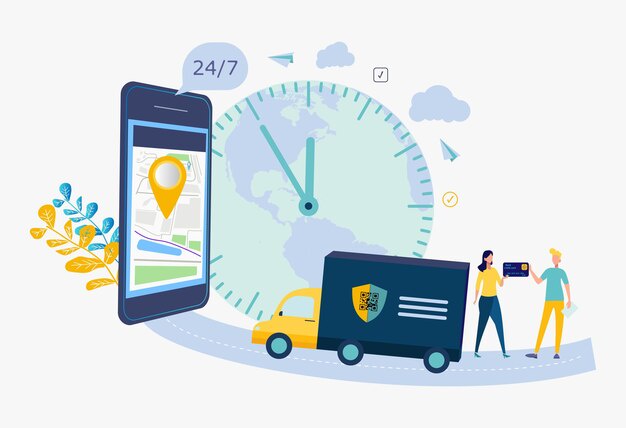Introduction
In today's fast-paced world, the demand for delivery applications has surged, making them a crucial tool for businesses of all kinds. Whether you manage a tiny local restaurant or a worldwide e-commerce site, the performance of your delivery app is critical to your business. To ensure that your software satisfies the expanding user expectations, three major characteristics must be prioritized: speed, dependability, and scalability. In this article, we will look at ways to optimize your delivery app for better performance, with a specific emphasis on three important criteria that can make delivery app development a success.
1. Make Delivery App Speed a Priority
When it comes to delivery apps, speed is everything. Users expect quick and responsive experiences, and any lag can cause irritation and desertion. Consider the following ways to improve the speed of your delivery app:
Efficient Codebase:
- Start by reviewing your app's codebase. Clean, well-structured code not only enhances speed but also simplifies maintenance and troubleshooting.
- Use the latest programming languages and frameworks optimized for speed and efficiency.
Server-Side Optimization:
- Optimize your server infrastructure to handle peak loads efficiently. This may involve using load balancers, content delivery networks (CDNs), and caching mechanisms.
- Implement server-side rendering to reduce the load on client devices, resulting in faster initial page loads.
Minimize HTTP Requests:
- Reduce the number of HTTP requests your app makes to the server. Combining multiple requests into one or minimizing unnecessary requests can significantly improve load times.
- Use asynchronous loading for non-essential content to prevent blocking the main user interface.
Image and Media Optimization:
- Compress and optimize images and media files to reduce their size without sacrificing quality. This can significantly speed up the delivery of visual content.
- Implement lazy loading for images, so they load only when they become visible to the user.
Content Delivery Networks (CDNs):
- Utilize CDNs to distribute content geographically closer to users. This reduces latency and speeds up content delivery, especially for global apps.
- Choose a CDN with excellent performance and reliability to ensure consistent user experiences.
Minimize Third-Party Scripts:
- Carefully evaluate and minimize the use of third-party scripts and dependencies, as they can introduce latency and impact performance.
- Consider loading third-party content asynchronously to prevent it from blocking your app's critical functionality.
2. Enhance Reliability to Build User Trust
A dependable delivery software must not only deliver products on time but also provide a pleasant user experience. Consider the following ways to increase user trust:
Robust Error Handling:
- Implement comprehensive error-handling mechanisms to gracefully manage unexpected issues, such as server errors or connectivity problems.
- Provide clear and user-friendly error messages that guide users on how to resolve common problems.
Real-Time Tracking:
- Enable real-time order tracking to keep users informed about the status of their deliveries. Use push notifications to update users on order progress.
- Ensure the accuracy and reliability of tracking data to build trust with your customers.
Secure Data Handling:
- Prioritize data security and privacy to protect user information. Implement encryption, authentication, and authorization mechanisms to safeguard sensitive data.
- Regularly audit and assess your app's security posture to identify and address vulnerabilities proactively.
Load Testing:
- Conduct rigorous load testing to simulate heavy user traffic and identify performance bottlenecks. This helps you proactively address issues before they impact real users.
- Continuously monitor your app's performance and scalability to stay ahead of potential reliability issues.
Redundancy and Failover:
- Implement redundancy in your server architecture to ensure uninterrupted service in the event of server failures. This may involve deploying backup servers or cloud-based failover solutions.
- Regularly test failover mechanisms to verify their effectiveness.
3. Scale Your Delivery App for Success
As your delivery app grows in popularity, you must scale it effectively to meet rising customer demand. Scalability ensures that your program can handle growing traffic and order quantities without slowing down. Here's how to scale your delivery app:
Cloud Computing:
- Utilize cloud computing platforms like AWS, Azure, or Google Cloud to easily scale your app's infrastructure up or down based on demand.
- Leverage auto-scaling features to automatically add or remove resources as needed, ensuring optimal performance and cost-efficiency.
Microservices Architecture:
- Adopt a microservices architecture, which allows you to break down your app into smaller, manageable services that can be independently scaled.
- This approach enhances flexibility and agility in responding to changing user needs.
Database Optimization:
- Optimize your database design and choose databases that are designed for scalability. Consider NoSQL databases for handling large volumes of unstructured data.
- Implement caching mechanisms to reduce the load on your database and speed up data retrieval.
Content Delivery:
- Distribute your app's content across multiple servers or data centers to reduce latency and improve content delivery speed.
- Use a global content delivery strategy to ensure a consistent user experience regardless of location.
Monitoring and Analytics:
- Implement robust monitoring and analytics tools to gain insights into your app's performance and user behavior.
- Use these insights to make data-driven decisions about when and how to scale your app's resources.
Conclusion
Optimizing for speed, reliability, and scalability is critical for success in the highly competitive world of delivery apps. You can supercharge your delivery app and give an excellent user experience by applying the ideas mentioned in this tutorial. Remember that speedy and dependable software that can scale easily will not only satisfy your current users but also attract new clients, eventually making your delivery app the market's go-to choice.
So, don't put it off any longer—start adopting these methods right away to make your delivery app the best it can be. Your app will be well-equipped to succeed in the ever-changing world of digital delivery services if you prioritize speed, dependability, and scalability.


No comments yet